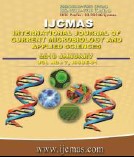


 National Academy of Agricultural Sciences (NAAS)
National Academy of Agricultural Sciences (NAAS)

|
PRINT ISSN : 2319-7692
Online ISSN : 2319-7706 Issues : 12 per year Publisher : Excellent Publishers Email : editorijcmas@gmail.com / submit@ijcmas.com Editor-in-chief: Dr.M.Prakash Index Copernicus ICV 2018: 95.39 NAAS RATING 2020: 5.38 |
Study was conducted to quantify trend in temperatures, its variability and spatial distribution and its influence on fruit production in north-west India for this purpose more than 30 years data on maximum and minimum temperatures of twenty two different agrometeorological stations of Jammu & Kashmir, Himachal Pradesh, Utrakhand, Punjab, Haryana, Chandigarh, Delhi, Uttar Pradesh and Rajasthan were used in this study. The temperature data was analyzed for computation of annual normal temperature and the coordinates were converted (into decimal system) for each meteorological station, for spatial analysis. Temperature trends for different meteorological stations in hills, plains of north-west India were evaluated using trend analysis. The map of north-west India was digitized and different temperature zones for maximum, minimum and mean temperature were delineated using GIS. Out of 22 stations, half of the stations showed a significant positive trend and another half negative trend in maximum temperature. A significant positive trend in minimum temperature of twenty stations but negative trend at Srinagar and Ranichauri was observed. Mean temperature showed significant positive trend at seventeen but negative at five stations. In north-west India as a whole a significant positive trend in annual maximum temperature (0.1 to 3.0°C/100 years), annual minimum temperature (1.5 to 1.6°C/100years) and in mean temperature (1.1 to 2.5°C/100 years) was observed. The North-west India was divided into six zones of maximum temperature, seven zones of minimum temperature and five zones of mean temperature by taking a class interval of 2.5°C. The study can be further refined by including the historical temperatures data of more and more meteorological stations located in the study area for better results.
 |
 |
 |
 |
 |